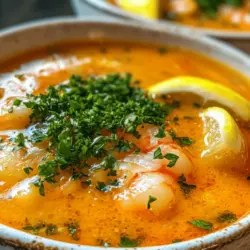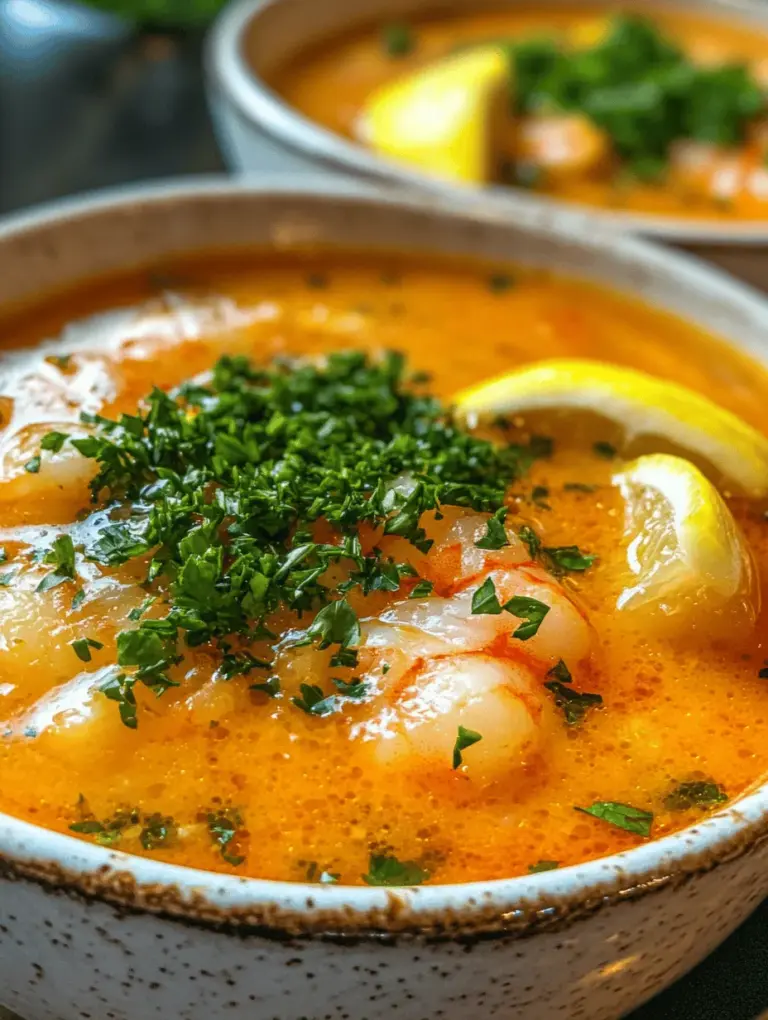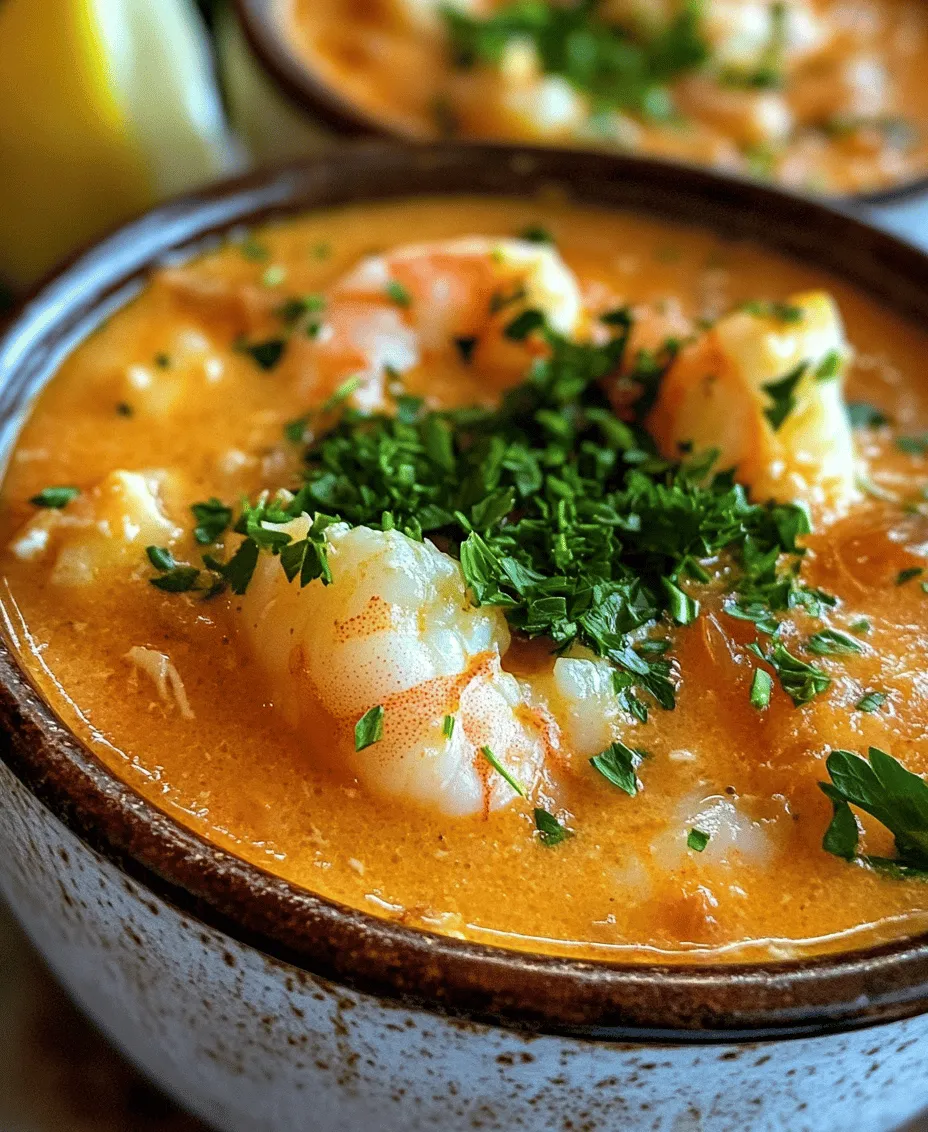Introduction
There’s something undeniably delightful about a warm bowl of seafood bisque. This classic French dish has earned its place in culinary hearts around the world, known for its luxurious flavors and creamy texture that evoke comfort and satisfaction. When you combine the succulent sweetness of fresh crab and shrimp, you elevate this bisque from a simple soup to an exquisite dining experience. Whether served as an elegant starter or a hearty main course, crab and shrimp seafood bisque is a celebration of the ocean’s bounty.
This recipe offers a harmonious blend of rich flavors and a velvety mouthfeel, making it a favorite among seafood lovers. Picture yourself cozying up with a bowl of this bisque on a chilly evening, the aroma of garlic and herbs wafting through the air, inviting you to take your first spoonful. With its balance of creaminess and depth, this bisque is not merely a meal; it’s an experience that warms both body and soul.
Understanding Seafood Bisque
To truly appreciate crab and shrimp seafood bisque, it’s essential to understand what bisque is and its significance in culinary traditions. Traditionally, bisque refers to a smooth and creamy soup made from crustaceans, typically enhanced with a rich broth. The term originated from the French word “bisque,” which relates to “bisque de homard,” meaning lobster bisque. Though lobster may be the most famous variant, bisques can be made with various seafood, including shrimp, crab, and even fish.
Historically, bisque was considered a gourmet dish, often reserved for special occasions and fine dining. Its roots can be traced back to the 17th century, where it was developed as a way to utilize leftover seafood shells. The shells were simmered to extract their flavors, creating a deeply savory broth that forms the foundation of any bisque. This technique not only maximized resources but also highlighted the luxurious nature of seafood.
What sets bisque apart from other types of soups is its smooth texture and rich flavor profile. While many soups may have a chunky consistency, bisques are generally pureed to achieve that silky finish. This characteristic is achieved through a combination of careful cooking, blending, and the addition of cream, resulting in a dish that feels indulgent yet remains comforting.
Ingredients Breakdown
Creating a phenomenal crab and shrimp seafood bisque starts with selecting the right ingredients. Each component plays a vital role in achieving the perfect balance of flavor and texture. Here’s a breakdown of the primary ingredients that make this bisque exceptional:
– Fresh Crab Meat and Shrimp: The stars of the dish are undoubtedly the crab and shrimp. Using high-quality fresh crab meat is essential for a pronounced seafood flavor. The sweetness of the crab pairs beautifully with the tender, juicy shrimp, creating a delightful combination that elevates the bisque. When selecting seafood, opt for sustainably sourced varieties to ensure quality and ethics.
– Unsalted Butter: Butter adds richness and depth to the bisque. Using unsalted butter allows you to control the seasoning better, ensuring that the natural flavors of the seafood shine through.
– Aromatic Vegetables: A classic mirepoix of onion, celery, and carrot serves as the aromatic base for the bisque. These vegetables provide a subtle sweetness and depth of flavor that enhance the overall profile of the soup.
– Garlic: Garlic is a key ingredient that contributes to the depth of flavor in the bisque. Its aromatic qualities complement the seafood beautifully, infusing the dish with warmth.
– Flour: A small amount of flour is used to thicken the bisque, giving it that luxurious creamy texture. It’s essential to cook the flour slightly to remove any raw taste before adding the broth.
– Seafood Stock: Choosing the right base is crucial. Seafood stock, made from simmering shells and fish bones, provides a robust flavor that enhances the bisque. If seafood stock is unavailable, a quality fish stock can serve as a suitable alternative.
– White Wine: A splash of white wine adds acidity to the bisque, brightening the overall flavor and complementing the seafood. Choose a dry white wine for the best results.
– Seasonings: To give the bisque a hint of spice, seasonings such as Old Bay seasoning and cayenne pepper can be added. Old Bay seasoning, a staple in seafood dishes, brings a blend of spices that perfectly complements the flavors of crab and shrimp.
– Garnishes: Fresh parsley and lemon wedges are essential for finishing the bisque. The parsley adds a pop of color and freshness, while the lemon offers a bright contrast to the rich flavors of the soup.
Step-by-Step Cooking Instructions
Now that we’ve explored the ingredients and their roles, let’s dive into the cooking process. Creating a crab and shrimp seafood bisque involves several steps, but the result is well worth the effort. Follow these detailed instructions for a perfect bisque:
1. Prepare the Seafood: Start by cleaning and preparing the fresh crab meat and shrimp. If using whole crabs, ensure they are cooked and cracked to extract the meat. For shrimp, peel and devein them, reserving the shells for later use in the stock.
2. Make the Seafood Stock: To create a flavorful base for your bisque, begin by making the seafood stock. In a large pot, combine the reserved shrimp shells with water, adding in aromatic herbs like bay leaves, thyme, and peppercorns. Bring to a boil, then reduce to a simmer for about 30 minutes. Strain the stock to remove the shells, and set aside.
3. Sauté the Aromatics: In a separate pot, melt unsalted butter over medium heat. Add finely chopped onions, celery, and carrots, sautéing until the vegetables are soft and translucent, about 5-7 minutes. Stir in minced garlic and cook for an additional minute, until fragrant.
4. Add the Flour: Sprinkle the flour over the sautéed vegetables, stirring constantly to create a roux. Cook for about 2 minutes, allowing the flour to cook through without browning.
5. Deglaze with White Wine: Pour in the white wine, stirring to deglaze the pot and scrape any flavorful bits stuck to the bottom. Allow the wine to simmer for 2-3 minutes to reduce and enhance the flavors.
6. Incorporate the Seafood Stock: Gradually add the prepared seafood stock to the pot, whisking constantly to ensure there are no lumps. Bring the mixture to a gentle simmer.
7. Add the Seafood: Once the bisque is simmering, add the fresh crab meat and shrimp to the pot. Cook for an additional 5-7 minutes, or until the shrimp are pink and opaque, and the crab is heated through.
8. Season the Bisque: Season the bisque with Old Bay seasoning, cayenne pepper, and salt and pepper to taste. Adjust the seasonings based on your preference, keeping in mind that the flavors will deepen as the bisque sits.
9. Blend for Smoothness: For a classic bisque texture, use an immersion blender to puree the bisque until smooth. If you prefer a chunkier texture, blend only half of the bisque and leave the rest as is.
10. Finish with Cream: Stir in heavy cream or half-and-half to achieve that signature creamy consistency. Allow the bisque to simmer for a few more minutes to meld the flavors.
In the next segment, we’ll discuss tips for achieving the best results, common questions about making seafood bisque, and more. Stay tuned as we explore the nuances that make this dish a true delight!
Importance of Sautéing Vegetables to Build Flavor
Sautéing the vegetables is a crucial step in preparing your Crab and Shrimp Seafood Bisque. This technique not only softens the vegetables but also enhances their natural sweetness, creating a rich, flavorful base for your bisque. Begin by heating a generous amount of butter or oil in your pot over medium heat. Add your onions, carrots, and celery, stirring frequently until they are soft and translucent. This process releases their essential oils and creates a depth of flavor that is foundational to your bisque.
The Maillard reaction occurs during this sautéing process, where the sugars and amino acids in the vegetables interact under heat, producing complex flavors. Remember, the more you build on the flavors at this stage, the more delicious your final dish will be.
Explanation of Creating a Roux and Its Significance in Texture
Next, you will create a roux, a mixture of flour and fat that serves as a thickening agent and adds an essential velvety texture to the bisque. To make the roux, sprinkle flour over the sautéed vegetables and stir continuously for about 2-3 minutes. Cook it until it turns a light golden brown, which indicates that the flour is cooked through, while still maintaining its thickening properties.
The significance of the roux cannot be overstated. It not only thickens the bisque but also contributes to the overall mouthfeel, allowing you to enjoy the creamy consistency without it being too heavy. A proper roux sets the stage for a bisque that flows smoothly over your palate, providing a luxurious dining experience.
Tips on Deglazing and the Importance of Scraping the Pot to Capture Flavors
After your roux is ready, it’s time to deglaze the pot. Pour in your seafood stock or white wine, scraping the bottom of the pot with a wooden spoon. This action releases any browned bits stuck to the bottom, which are packed with flavor, enhancing the overall taste of your bisque.
Deglazing is a critical technique; it ensures that every bit of flavor contributes to the final dish. The alcohol in the wine or the depth of the stock will lift those delicious morsels, incorporating them into the bisque for a layered flavor profile. Allow the mixture to simmer for a few minutes until slightly reduced, intensifying the taste even further.
The Significance of Simmering and Seasoning in Developing the Bisque’s Richness
Simmering is where the magic happens. Once the base of your bisque is ready, add your seafood and any additional seasonings. Bring the mixture to a gentle simmer, allowing the flavors to meld together beautifully. This step is crucial; a rapid boil can toughen the seafood, while a slow simmer allows the ingredients to interact harmoniously.
Seasoning is equally important. Start with salt and pepper, tasting as you go. You can also add aromatics like bay leaves, thyme, or even a touch of cayenne for heat. Each ingredient should complement the seafood without overpowering its delicate flavor. A bisque is about balance; too much seasoning can mask the natural sweetness of the crab and shrimp.
Gentle Handling of Seafood to Maintain Texture and Prevent Overcooking
When adding the crab and shrimp, handle the seafood gently to maintain its texture. Add the shrimp first, as they take slightly longer to cook than crab meat. Allow them to cook just until they turn pink, which should take about 2-4 minutes.
Once the shrimp are nearly done, fold in the crab meat delicately, ensuring it stays in large chunks for a luxurious bite. The goal is to prevent overcooking, which can lead to rubbery shrimp and mushy crab. Remember, the residual heat from the bisque will continue to cook the seafood, so it’s best to err on the side of slightly undercooked.
Final Touches: Incorporating Cream and Adjusting Seasonings for Balance
Once the seafood is cooked to perfection, it’s time to enrich your bisque with cream. Gently stir in heavy cream to achieve a rich, velvety texture. This addition not only enhances the flavor but also adds a touch of indulgence to your dish.
Before serving, taste your bisque one last time to adjust the seasonings. A squeeze of fresh lemon juice can brighten the flavors and balance the richness of the cream. If desired, a sprinkle of fresh herbs like parsley or chives can add a touch of freshness and color.
Nutritional Information
The Crab and Shrimp Seafood Bisque is not only a delicious comfort food but also a dish that brings nutritional benefits to the table. Both crab and shrimp are excellent sources of high-quality protein, low in fat, and rich in essential nutrients.
Overview of the Nutritional Benefits of Crab and Shrimp
Crab is particularly high in vitamins B12 and C, as well as minerals like zinc and selenium, which are vital for immune function and overall health. Shrimp, on the other hand, offers a significant amount of iodine, which is important for thyroid function, along with antioxidants like astaxanthin that help combat oxidative stress.
Discussion on the Health Aspects of the Ingredients Used
The vegetables used in your bisque, such as onions, carrots, and celery, contribute dietary fiber and essential vitamins. Heavy cream, while higher in calories, provides calcium and can be enjoyed in moderation as part of a balanced diet.
Caloric Content and Serving Size Overview
A typical serving of this bisque can range from 300 to 400 calories, depending on the portion size and the amount of cream added. This makes it a satisfying meal that can be enjoyed without the guilt, especially when paired with fresh salads or crusty bread.
Pairing Suggestions
To elevate your dining experience, consider complementing your Crab and Shrimp Seafood Bisque with carefully selected side dishes and beverages.
Recommended Side Dishes that Complement the Bisque
Crusty bread is a classic pairing, perfect for dipping into the creamy bisque. A fresh green salad with a light vinaigrette can provide a refreshing contrast to the richness of the soup. You might also consider serving a light vegetable medley or roasted asparagus for added texture and flavor.
Best Beverage Pairings, Including Wine Recommendations
When it comes to beverages, a crisp white wine like Sauvignon Blanc or a light-bodied Chardonnay pairs beautifully with seafood bisque. The acidity in these wines cuts through the richness of the cream and enhances the flavors of the seafood. For non-alcoholic options, a sparkling water with a slice of lemon or a light herbal iced tea can refresh your palate.
Exploring How to Serve the Bisque for a Complete Dining Experience
To serve the bisque, ladle it into warm bowls and garnish with fresh herbs or a drizzle of olive oil for an elegant touch. Consider presenting the bisque with the crusty bread on the side, allowing your guests to enjoy a complete sensory experience.
Variations and Adaptations
This seafood bisque is versatile, allowing for various adaptations to cater to dietary preferences and personal tastes.
Suggestions for Adapting the Recipe for Dietary Preferences
For a gluten-free version, substitute the all-purpose flour in the roux with a gluten-free flour blend or cornstarch. For those who wish to avoid dairy, consider using coconut cream or almond milk to achieve a similar creamy texture without the heaviness.
Creative Variations to the Seafood Bisque
Feel free to experiment with different seafood options. Lobster, scallops, or even mussels can be fantastic additions or substitutes, creating a bisque that’s uniquely tailored to your preferences.
Ideas for Adding Spices and Herbs to Customize Flavor Profiles
Spices can dramatically change the flavor profile of your bisque. Consider adding a touch of Old Bay seasoning for a more traditional seafood flavor, or a pinch of saffron for an exotic twist. Fresh herbs like dill, tarragon, or even a hint of smoked paprika can add depth and complexity to your dish.
Conclusion
The Crab and Shrimp Seafood Bisque is not just a dish; it’s a culinary experience that combines comfort and gourmet flair. With its rich flavors, creamy texture, and the delightful sweetness of fresh seafood, this bisque is perfect for special occasions or cozy dinners at home.
Embark on this cooking journey and discover the joy of creating a dish that celebrates fresh ingredients and the art of cooking. Share this bisque with loved ones, and enjoy the moments spent around the table, creating memories that last a lifetime. Whether it’s a chilly evening or a festive gathering, this indulgent bisque will surely impress and satisfy everyone at the table.



